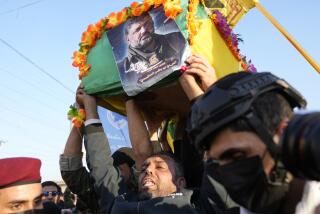Review: ‘Black Flags: The Rise of ISIS’ offers brilliant biography of Abu Musab Zarqawi
Ahmad Fadil was a high school dropout, a video store clerk and a petty gangster who got tattoos, drank alcohol and sold drugs as a youth in Zarqa, his hometown in northeast Jordan.
His mother was so alarmed she sent him to a Muslim self-help class, and he soon found another calling. By the time a U.S. airstrike killed him in 2006, Abu Musab Zarqawi — Fadil’s nom de guerre — had led the Sunni insurgency in Iraq that killed tens of thousands of people and humbled a global superpower by miring it in a vicious civil war.
Zarqawi — or the “sheikh of the slaughterers” as his admirers called him — also laid the foundation for the Sunni extremist army now known as Islamic State, or ISIS. Following his messianic beliefs and bloodlust, jihadis have beheaded captives, destroyed antiquities, reintroduced slavery and declared a strict Islamist caliphate in Iraq and Syria that has drawn adherents from around the globe.
Joby Warrick’s “Black Flags: The Rise of Isis” is invaluable for anyone struggling to understand the gruesome excesses and inexplicable appeal of ISIS. It has cycled through several names and leaders, but the fanatic religious movement founded by Zarqawi has eclipsed Al Qaeda in influence, scale and ambition. It now threatens to remake the Middle East.
Warrick, a Pulitzer Prize-winning reporter and a fluid writer, takes the tale back to Zarqawi’s early years. He joined a warlord’s militia in Afghanistan in 1989 and earned his stripes as a mujahid — a holy warrior. He then aligned himself with Osama bin Laden and organized bombings and assassinations in Jordan that landed him in jail until an amnesty in 1999.
Still, he was a minor figure until then-U.S. Secretary of State Colin L. Powell addressed the United Nations in February 2003 to urge war against Iraq. In addition to other errors, Powell wrongly accused Saddam Hussein of harboring Zarqawi, showing his scowling bearded face on TV screens around the world. The speech “transformed Zarqawi from an unknown jihadist to an international celebrity and the toast of the Islamist movement,” Warrick writes.
After the U.S.-led 2003 invasion, Zarqawi built a resistance network of embittered Iraqis and foreign jihadists. He sent suicide bombers to blow up embassies, hotels and other Western targets, including the U.N. headquarters in Baghdad, to discredit the American occupation. Then his fighters began bombing and beheading Shiite Muslims and destroying their holy sites. As Zarqawi had hoped, it turned the anti-U.S. insurgency into a civil war between Shiites and Sunnis, a sectarian bloodletting that still is playing out.
In May 2004, Zarqawi issued a video that showed him, as the title explained, “slaughtering an American” named Nick Berg. The snuff video shocked Americans. It also gave Zarqawi the confidence to announce he would build an Islamist super-group that would erase international borders, topple governments and establish a caliphate. Even Bin Laden wasn’t that audacious. U.S. authorities increased the dead-or-alive bounty for Zarqawi to $25 million — the same as for Bin Laden.
By 2005, Zarqawi had more fighters, money and weapons than Al Qaeda ever commanded. Unlike Bin Laden and his aides, his followers were fighting and killing Americans every day in Iraq. And unlike Bin Laden’s ponderous video sermons, Zarqawi used the Internet to bolster his reputation as a fierce jihadist and outlaw warrior. He dressed in ninja black, not flowing robes, and posted grisly images that attracted thousands of young men who believed he was avenging Muslims for centuries of humiliation and defeat.
To the surprise of U.S. intelligence officials, Zarqawi’s death in June 2006 — thanks to a tip from Jordanian intelligence — didn’t destroy his movement. Eight years later, in the spring of 2014, Islamic State fighters surged back into the spotlight. Racing out of Syria into western Iraq, black-clad fighters routed four Iraqi army divisions, overran a series of military bases and seized control of nearly a third of the country, including major cities, oil refineries, banks and military bases.
Unfortunately, that’s where the authoritative narrative in “Black Flags” slows. Warrick has written a brilliant biography of Zarqawi and a gripping account of the officials in Jordan, Washington and elsewhere who tracked his career and ultimately chased him down. It is less convincing at explaining the subsequent “rise of ISIS,” as the title promises.
Zarqawi’s death “changed everything,” Warrick acknowledges. When not butchering innocents, ISIS officials now collect taxes, pump oil, fix potholes and run a quasi state, bureaucratic tasks Zarqawi never considered. More importantly, ISIS fighters have violated the first rule of guerrilla warfare by holding and fighting for territory — yet have stalemated the military might of scores of countries, including both the U.S. and Iran.
Various reasons are offered to explain the group’s success — the multi-sided civil war in Syria, Sunni fury at the Shiite-led government in Baghdad, Iraqi army officers who switched sides, sophisticated use of social media and so on. All are factors, but none is fully satisfying. Alas, there’s time to search for an answer. As this seminal book makes alarmingly clear, Zarqawi’s appalling legacy won’t fade any time soon.
Drogin is deputy bureau chief and national security editor in the Washington, D.C., bureau.
::
Black Flags: The Rise of Isis
Joby Warrick
Doubleday, 368 pages, $28.95
More to Read
Sign up for our Book Club newsletter
Get the latest news, events and more from the Los Angeles Times Book Club, and help us get L.A. reading and talking.
You may occasionally receive promotional content from the Los Angeles Times.







